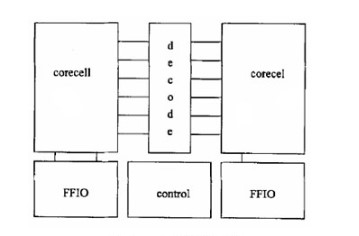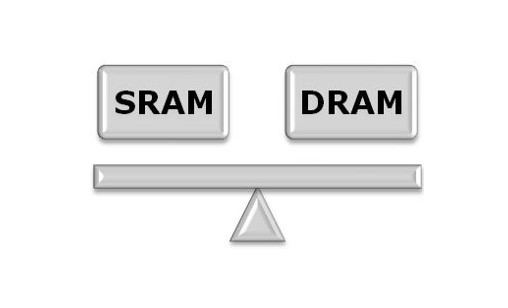Time: 2023-12-21 16:48:52View:
SRAM, which stands for Static Random Access Memory, is a form of semiconductor technology in the vemeko system. SRAM is primarily used for Level 2 cache. It utilizes transistors to store data. Compared to DRAM, SRAM is faster, but its capacity is smaller in the same area compared to other types of memory.
The basic architecture of SRAM is shown below, which can generally be divided into five main parts: core cells array, row/column address decoder, sense amplifier, control circuit, and buffer/drive circuit (FFIO). SRAM operates in a static storage mode, using bistable circuits as storage units. Unlike DRAM, it does not require constant refreshing and operates at a faster speed. However, due to the large number of storage components, the integration density is not very high and it also consumes a relatively large amount of power.

There are different types of SRAM based on the technology used in their construction. Bipolar junction transistor (BJT) SRAM, MOSFET (Metal-Oxide-Semiconductor Field-Effect Transistor) SRAM, and FinFET SRAM are some of the common types. Each type has its own advantages and disadvantages in terms of speed, power consumption, and density.
BJT SRAM
BJT SRAM, or Bipolar Junction Transistor SRAM, is a type of static random-access memory that uses bipolar junction transistors in its construction. Bipolar junction transistors are three-terminal semiconductor devices that can be used for amplification or switching of electronic signals. In BJT SRAM, these transistors are used to create the memory cells that store the data.
One of the key characteristics of BJT SRAM is its high speed. Bipolar junction transistors are known for their fast switching speeds, which makes BJT SRAM well-suited for applications where rapid access to data is essential. Additionally, BJT SRAM typically consumes more power compared to other types of SRAM, such as MOSFET SRAM, due to the nature of bipolar junction transistors.
Despite its higher power consumption, BJT SRAM is favored in certain applications where speed is paramount, such as in high-performance computing and communication systems. Its ability to provide fast access to data makes it a valuable component in the design of high-speed cache memories and other critical parts of modern digital electronics.
MOSFET SRAM
MOSFET SRAM, or Metal-Oxide-Semiconductor Field-Effect Transistor SRAM, is a type of static random-access memory that utilizes metal-oxide-semiconductor field-effect transistors in its design. MOSFETs are widely used in integrated circuits and are known for their low power consumption and high noise immunity, making them suitable for a variety of applications, including memory storage.
MOSFET SRAM is characterized by its low power requirements and high density. Compared to BJT SRAM, MOSFET SRAM typically consumes less power, making it more energy-efficient. This is particularly advantageous in battery-powered devices and other applications where power efficiency is crucial. Additionally, MOSFET SRAM can be manufactured with higher densities, allowing for more memory to be packed into a smaller area.
The use of MOSFETs in SRAM also contributes to its high speed and reliability. MOSFET transistors can switch quickly and are less susceptible to certain types of electrical noise, making MOSFET SRAM well-suited for high-speed and high-reliability applications.
FinFET SRAM
FinFET SRAM, which utilizes Fin Field-Effect Transistors, is a type of static random-access memory known for its high performance and low power consumption. FinFET technology allows for better control over the flow of current, resulting in improved efficiency and reduced leakage compared to traditional planar transistors. This makes FinFET SRAM an attractive choice for applications where both speed and energy efficiency are critical, such as in mobile devices, high-performance computing, and other advanced electronics.
SRAM (Static RAM) is also composed of transistors. When connected, it represents 1, and when disconnected, it represents 0, and the state will remain until a change signal is received. These transistors do not need to be refreshed, but like DRAM, they will lose information when shut down or powered off. SRAM operates at very high speeds, typically at 20ns or faster. A single DRAM storage unit only requires one transistor and a small capacitor, while each SRAM unit requires four to six transistors and other components. So in this term,it is a little expansive.
Below is a related video:
SRAM (Static Random-Access Memory) and DRAM (Dynamic Random-Access Memory) are two common types of semiconductor memory used in modern computer systems, each with its own set of advantages and disadvantages.
SRAM is faster and more expensive than DRAM. It is often used in cache memory and for high-speed registers in microprocessors and other digital electronics. SRAM is distinguished by its ability to retain stored information as long as power is supplied to the system. This is in contrast to DRAM, which needs to be refreshed periodically to maintain the data. SRAM is made up of flip-flops, which are electronic circuits that can store one bit of data each. These flip-flops form the memory cells of the SRAM. Due to its faster access times and lower latency, SRAM is well-suited for applications that require rapid access to data, such as CPU caches and high-performance computing systems.
On the other hand, DRAM is slower and less expensive than SRAM. It is the most common type of computer memory and is used in a wide range of electronic devices. DRAM stores each bit of data in a separate capacitor within an integrated circuit. However, due to the nature of the capacitor, the stored charge gradually leaks away, requiring periodic refresh cycles to maintain the data. This refresh process introduces additional latency compared to SRAM. Despite its slower access times, DRAM is favored for its higher density and lower cost per bit, making it suitable for applications where large amounts of relatively slow memory are required, such as main memory in personal computers and servers.
To be concise, it can be concluded as the following points:
SRAM has a relatively high cost.
DRAM has a lower cost (1 field effect transistor plus one capacitor).
SRAM has a faster access speed.
DRAM has a slower access speed (due to the capacitor charging and discharging time).
SRAM is generally used in high-speed caches.
DRAM is generally used in memory modules.

SRAM finds applications in a wide range of electronic devices and systems due to its unique characteristics, including high speed, low power consumption, and ability to retain data without the need for periodic refreshing. One of the primary applications of SRAM is in CPU (Central Processing Unit) caches. SRAM's fast access times make it ideal for storing frequently accessed data and instructions, allowing the CPU to retrieve information quickly, which in turn enhances overall system performance. Additionally, SRAM is used in various levels of cache memory, including L1, L2, and L3 caches, to optimize data access and improve computational efficiency in modern microprocessors.
Another significant application of SRAM is in networking devices, such as routers, switches, and network interface cards. These devices often require high-speed memory to buffer and process incoming and outgoing data packets. SRAM's fast read and write times make it well-suited for these applications, enabling efficient data handling and forwarding within networking equipment, ultimately contributing to the smooth operation of communication networks.
Furthermore, SRAM is utilized in high-performance graphics cards and video processing units (GPUs) to store frame buffers, texture maps, and other graphics-related data. The rapid access times of SRAM are crucial for rendering complex visual scenes and ensuring smooth, responsive graphics performance in gaming, digital content creation, and professional visualization applications.
In addition to these applications, SRAM is employed in various embedded systems, such as automotive electronics, industrial control systems, and consumer electronics. Its ability to operate at high speeds and retain data without constant power supply makes it suitable for applications where instant access to critical information is essential, such as in real-time control systems, automotive safety systems, and portable electronic devices.
In summary, SRAM's versatility and high-speed operation make it an integral component in a wide array of electronic devices and systems, contributing to improved performance, responsiveness, and efficiency across diverse technological domains.